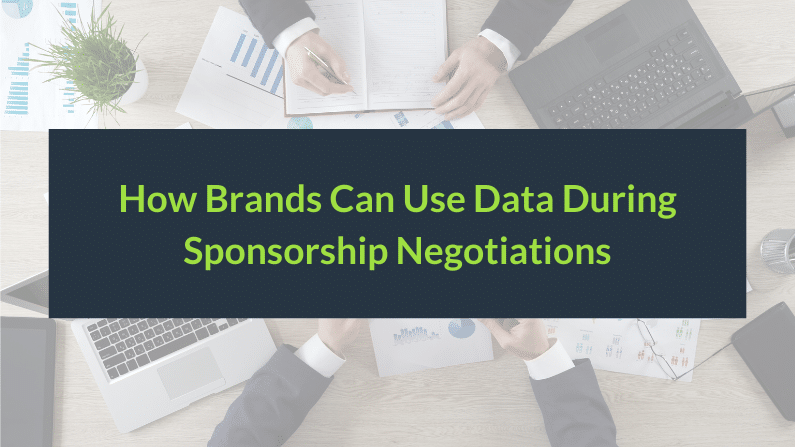How Spontech Can Help You When Renewing Contracts
The last several years have brought a lot of changes to the sponsorship world. Of these changes is the move to more effectively reach target audiences with partners through social media. Social has become the #1 way for a brand to drive value through athletes and sponsors, but often is not utilized to its fullest. Due to the importance of and budget invested in these partnerships, it has become increasingly important to use social valuation data when negotiating contracts with sports partners and athletes, ensuring your investment is worth it.
Here are three steps that you can take in contract negotiations to ensure your partners are driving value through social media.
1. Review the contract
When beginning a contract renegotiation process, the first step should be to look at your current contract with the athlete or partner. Did you have any clauses that specified how your brand needs to be represented on social media and how often? If not, you should consider adding specific detail and goals to the new contract. If you did, then you must analyze if these metrics were achieved. This can be determined through asking these questions:
- How many posts were made?
- What platforms were these posts on?
- How well did they position the brand?
- Were they ads? Did they feel authentic?
- How much engagement did they get?
- How much value did they drive for the brand?
Perhaps the most important aspect of partnership promotion through social media is the amount of value that was added to the brand. In the previous contract, were there any requirements for the value that needs to be created? If this is not included, this should be considered to be added in the contract renewal.
A way to encourage the level of value desired may be introducing incentives for reaching a certain threshold, known as performance-based sponsorships. In short, performance based sponsorships are agreements that set goals for partners to achieve that are in line with brand goals. Some of these goals can be “on-field” based goals such as making or winning the playoffs. Other goals are more brand-focused, such as a certain level of engagement or video views on posts promoting the brand. Typically, there are several tiers of payout, encouraging the partner to be a better promoter of the brand and driving more brand value. Refer to our other articles for a more detailed look at what are performance-based sponsorships and how to implement incentives into partnership contracts. If you already have this in your contract, look into what levels the promoter achieved. Leading brands are not only setting thresholds, but allowing their partners to see how well other partners are promoting their brand and stack ranking their partners, playing into the competitive nature of every athlete.
A simple tactic that may help to drive value for your brand is to understand what types of posts are receiving the most engagement. Let’s take a look at this post by Tom Brady for example. This post all in all had 1.3M likes and 55K comments. With all that engagement, the post had a Max Ad Value of nearly $350k. However, for Under Armour, which has a few logos visible in the post, the value was only $38k, all incidental logo-display value. Despite the 11% promotional effectiveness of the post and the fact the post was not a deliberate advertisement, it still drove value for Under Armour. Had Brady intentionally branded the post with a larger UA logo and thanked his partner in the text, the post could have driven significantly more value. Clearly, it is important to analyze which posts from your partners typically garner the highest amount of engagement. Once you understand what posts gain the most traction, it is important to align your brand with them. Through understanding what drives the most engagement, you can work with and coach your partners to integrate your brand into these posts to provide optimal value. In this example, this could be implemented through having Tom Brady better include Under Armour in posts like this that drive high engagement.
2. Benchmarking against other partners
A comparison of the spend in relation to the value generated is extremely important in renegotiations. In other words, what percentage of your sponsorship budget does this promoter take up? When this question has been answered you must then compare this to the value generated by the same promoter. Is the value they are generating driving the same percentage of total value that you are paying them in sponsorship? For example, if this partner is 20% of your sponsorship budget and returns 5% of the sponsorship value, that’s not great. But if they are generating 50% of the sponsorship value, that’s good! (consider re-thinking the effectiveness of your other partnerships though…)
Consider this example with Stephen Curry and Under Armour. While this is from a short, 30-day timeframe, the actual value generated for the brand was only slightly over $100k. Even multiplied out by 12, this is well below the reportedly $20M that Under Armour pays Curry each year. However, when compared to the rest of the portfolio during the same time period, Curry may carry his weight in terms of budget percentage. During the same period, Tom Brady drove about ¼ the value that Curry did ($33k), Cam Newton and Bryce Harper combined drove less than 10%. From this percentage perspective, Curry is one of the better performers for the brand, even if none of the partners are driving high value.
3. Conduct an assessment of other key factors
There are a few other social metrics and key factors that should be considered when negotiating a new contract. The first to look at would be to analyze how often the promoter is posting about your brand. Your brand should be remaining relevant on the feeds of your promoters. In general, a promoter should be posting about your brand one or more times per week across multiple platforms to achieve the right frequency of posts. While frequency is important, it is also important to evaluate the quality of these posts. Your logo should be clearly shown in the image or video along with text promotion using hashtags promoting the brand at or near the beginning of the text.
Additionally, you should also be looking at how your metrics are trending. Are there times that posts are driving more value then at other times? The best example of this are special events that do not occur regularly such as a World Cup, Olympics, or Championship series or games. If your metrics tend to spike during certain months or around certain events, it may be wise to lean into this with your partners. However, you do not want to put all energy behind these special events and should put in a system with your partner that will help to drive value throughout the year. By combining these actions, sponsorship value will increase over time. This trend is also key to look at – has this partner’s sponsorship value generated for your brand increased over the past year or are they contributing less to your portfolio? If they are doing more, this is a good indication of a partner you’d likely do well to re-sign.
Lastly, look at what your brand goals are that you want to achieve through this partnership. An analysis of the audience that this promoter reaches can help your brand understand if this partnership will reach your target consumer. One simple way to look at this is a follower overlap comparison of that partner’s followers compared to the brand’s followers. Are they magnifying the voice of the brand a similar group of dedicated fans or do they bring a new set of people to the brand that the brand would not have reached and engaged otherwise? This process will help you to see if you are aligning your brand correctly through this partnership or if there are other partnerships that will help you reach the right audience.
For example, 56% of Serena Williams followers on Instagram and Facebook are female. This means that if you are a company that focuses on male clientele, such as a home improvement store like Lowe’s or Home Depot, you may want to reconsider if you want to partner with Serena Williams unless you are looking to reach a new target audience. This reasoning can also be used for looking at other demographic information such as age, location, and many others. Looking at key metrics of your target customer base and benchmarking them against the follower metrics of the athletes you would want to sponsor will help tremendously to align yourself with your customer.
Key Takeaways
In conclusion, there are many steps that you can take to ensure that your brand promoters are optimally promoting your brand. Data provided by Hookit is essential to ensuring that your sponsorship portfolio is being optimized. While building new relationships with your promoters is important, it is equally as important to understand how these relationships are driving value. Before you go to the negotiating table, make sure you know how well that partner is doing for your brand compared to your other partners and be ready to defend your position.


